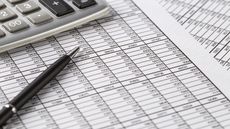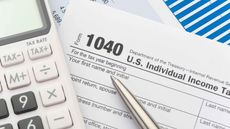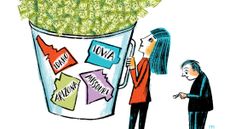Year-End Investing Moves to Avoid
Watch out for the tax consequences of buying or selling mutual funds now.

Mutual fund investors ... brace yourselves! Funds are about to begin doling out billions of dollars in year-end distributions.
This year's largesse will surpass last year's record of $481 billion, estimates Tom Roseen, a senior research analyst for Lipper, a firm that specializes in mutual fund information. Roseen says three factors are driving the enormous payouts:
- Carry-over losses from the 2000-2001 down market -- which managers have used to offset gains in recent years -- have been pretty much used up.
- As more investors shift from small-capitalization and value stocks to big-company and growth stocks, fund managers have had to realign portfolios, realizing gains that now have to be distributed.
- The volatility that has plagued the market this year has prompted investors to move in and out of funds which, again, has forced managers to sell stocks.
| Row 0 - Cell 0 | The Kiplinger Mutual Fund Center |
| Row 1 - Cell 0 | 10 Smart Year-End Money Moves |
| Row 2 - Cell 0 | Sneak Peak at 2008 Tax Savings |
The combination could push 2007 fund distributions over the half-trillion-dollar mark.It can bring both tax headaches and opportunities.

Sign up for Kiplinger’s Free E-Newsletters
Profit and prosper with the best of expert advice on investing, taxes, retirement, personal finance and more - straight to your e-mail.
Profit and prosper with the best of expert advice - straight to your e-mail.
First the headache part: Distributions threaten investors who buy a fund just before a payout. That might seem pretty smart: After all, you get a full-year's income even if you've owned for just a few days. But it's really a blunder.
When the distribution is paid, the share value falls by the same amount. A $10 payout knocks $10 off the share price. Recent buyers effectively get a rebate of part of the purchase price.
The bad news is you have to pay tax on that "refund." You're better off buying just after the ex-dividend date rather than just before it.
Now, for the opportunity: If you're planning to sell a fund soon, you're probably better off doing it before rather than after the distribution.
Remember, what's being paid out may be a combination of long-term gains realized by the fund, short-term gains, interest and dividends. Before the payout, it's all built into the share price.
So if you've owned the fund for more than a year, all the profit on the sale will be treated as a long-term capital gain -- taxed at a maximum rate of 15%.
If you sell after the payout, you'll have less gain to report because the share price falls. But part of the distribution -- the part that represents short-term gains, non-qualifying dividends and interest -- can be taxed as high as 35%. Selling sooner rather than later lets you dodge that inflated tax bill.
Again, let's look at a $10 per share distribution made up of $3 a share of long-term gains, $1 a share of qualifying dividends, $3 a share of short-term gains and $3 a share of interest.
If you sell before the payout, the entire $10 is built into the share price, lifting your profit by $10 a share ... all of which is tax-favored capital gains. If you have 1,000 shares, the $10,000 of profit costs you $1,500 in tax.
But what happens if you sell just after the distribution?
Because the share price has fallen by $10 to account for the payout, your profit drops by $10,000. And, with $10,000 less long-term capital gain income to report, your tax bill falls by $1,500.
That's a good thing, but consider the cost: The $6 a share of the distribution made up of short-term gain and interest would now be taxed at your top bracket. In the 35% bracket, that would cost you $2,100. And the $4,000 of the payout made up of long-term gains and qualifying dividends would be taxed at 15%, adding add another $600 to the bill.
Tax on the $10,000 if you sell before the distribution: $1,500. Tax if you sell afterward: $2,700.
So, selling sooner rather than later in this example would save you $1,200.
Never let the tax consequences control when you buy or sell a mutual fund. But, if you've decided to buy or sell in the final few weeks of the year, watch the calendar. A few days difference could pay off handsomely. Mutual fund Web sites often include information on the size and timing of year-end distributions.

-
 Home Energy Improvements Benefit Both Your Wallet and the Environment
Home Energy Improvements Benefit Both Your Wallet and the EnvironmentHome energy improvements let you save on electricity bills while also reducing greenhouse gas emissions.
By Erin Bendig Published
-
 Free Coffee on National Cold Brew Day Saturday, April 20th
Free Coffee on National Cold Brew Day Saturday, April 20thJust in time for National Cold Brew Day, Dunkin', Pilot and Flying J Travel Centers, La Colombe and Dutch Bros. are offering up crave-worthy deals.
By Kathryn Pomroy Published
-
 Kiplinger's Tax Map for Middle-Class Families: About Our Methodology
Kiplinger's Tax Map for Middle-Class Families: About Our Methodologystate tax The research behind our judgments.
By David Muhlbaum Published
-
 Retirees, Make These Midyear Moves to Cut Next Year's Tax Bill
Retirees, Make These Midyear Moves to Cut Next Year's Tax BillTax Breaks Save money next April by making these six hot-as-July tax moves.
By Rocky Mengle Published
-
 Estimated Payments or Withholding in Retirement? Here's Some Guidance
Estimated Payments or Withholding in Retirement? Here's Some GuidanceBudgeting You generally must pay taxes throughout the year on your retirement income. But it isn't always clear whether withholding or estimated tax payments is the best way to pay.
By Rocky Mengle Published
-
 How to Cut Your 2021 Tax Bill
How to Cut Your 2021 Tax BillTax Breaks Our guidance could help you claim a higher refund or reduce the amount you owe.
By Sandra Block Published
-
 Why This Tax Filing Season Could Be Ugly
Why This Tax Filing Season Could Be UglyCoronavirus and Your Money National Taxpayer Advocate Erin M. Collins warns the agency will continue to struggle with tight budgets and backlogs. Her advice: File electronically!
By Sandra Block Published
-
 Con Artists Target People Who Owe The IRS Money
Con Artists Target People Who Owe The IRS MoneyScams In one scheme, thieves will offer to "help" you pay back taxes, only to leave you on the hook for expensive fees in addition to the taxes.
By Rivan V. Stinson Published
-
 Cash-Rich States Lower Taxes
Cash-Rich States Lower TaxesTax Breaks The economic turnaround sparked a wave of cuts in state tax rates. But some say the efforts could backfire.
By Sandra Block Published
-
 The Financial Effects of Losing a Spouse
The Financial Effects of Losing a SpouseFinancial Planning Even amid grief, it's important to reassess your finances. With the loss of your spouse's income, you may find yourself in a lower tax bracket or that you qualify for new deductions or credits.
By Rocky Mengle Published